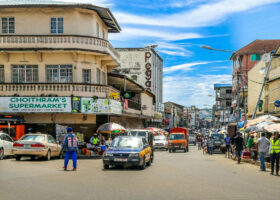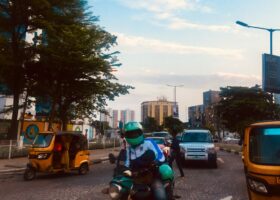
Overview
Tactical urbanism is a quick and affordable approach to piloting and practically demonstrating change in the built environment, led by either planning authorities or civil society. It identifies a current need, and then reallocates road or other public space using short-term, low-cost, and scalable interventions to catalyse long-term change. Such approaches were applied widely during the 2020 COVID-19 pandemic, to offer opportunities for physically distanced travel for both non-motorised and public transport.
Yet piloting through tactical urbanism is not an approach readily used in Sub-Saharan Africa (SSA) cities to date, neither routinely nor during 2020. Instead, SSA governments focused on capacity-reducing requirements on road and rail-based public and paratransit transport rather than also introducing pop-up infrastructure to facilitate walking and cycling and, potentially, public transport reliability and frequency.
This paper investigates why tactical urbanist approaches were rarely considered in SSA cities as a pandemic response, and considers further why ‘infrastructure-lite’ approaches to public and non-motorised transport, more generally, might not find favour in local contexts. Pilots, in this form, could have particular value for resource-constrained authorities that have multiple and contested demands on budget allocations, and a need to demonstrate the legitimacy of cycling and public transport spend.
The paper synthesises a series of research reports led by both authors: ‘Learning from COVID-19 pop-up bicycle infrastructure: an investigation into flexible and user-led bicycle planning in Cape Town, Nairobi and Kampala’, and ‘Fast-tracking public transport priority: Investigating the potential of Tactical Transit Lanes in mitigating the impact of COVID-19 in cities in SubSaharan Africa’.
Publications with the same themes
Publications with the same study countries
Related news & events
News
Blog
Blog
News
News
News
Blog
News
Blog
PDF content (text-only)
_______________________________ 1 These terms were used because they are relatively standard and generally understood in the literature, although we acknowledge their problematic nature. LEARNING FROM COVID-19 TACTICALURBANISM: CHALLENGES AND OPPORTUNITIESFOR ‘INFRASTRUCTURE-LITE’IN SUB-SAHARANAFRICAN CITIES R JOBANPUTRA1 and G JENNINGS2 1 PO Box 1277, Sun Valley, Cape Town 7979; Tel: 082 770 3870 Email: rahul@jobanputra.me 2 PO Box 181, Noordhoek, Cape Town 7979; Tel: 083 658 5386 Email: gail@gailjennings.co.za ABSTRACT Tactical urbanism is a quick and affordable approach to piloting and practically demonstrating change in the built environment, led by either planning authorities or civil society. It identifies a current need, and then reallocates road or other public space using short-term, low-cost, and scalable interventions to catalyse long-term change. Such approaches were applied widely during the 2020 COVID-19 pandemic, to offer opportunities for physically distanced travel for both non-motorised and public transport. Yet piloting through tactical urbanism is not an approach readily used in Sub-Saharan Africa (SSA) cities to date, neither routinely nor during 2020. Instead, SSA governments focused on capacity-reducing requirements on road and rail-based public and paratransit transport rather than also introducing pop-up infrastructure to facilitate walking and cycling and, potentially, public transport reliability and frequency. This paper investigates why tactical urbanist approaches were rarely considered in SSA cities as a pandemic response, and considers further why ‘infrastructure-lite’ approaches to public and non-motorised transport, more generally, might not find favour in local contexts. Pilots, in this form, could have particular value for resource-constrained authorities that have multiple and contested demands on budget allocations, and a need to demonstrate the legitimacy of cycling and public transport spend. The paper synthesises a series of research reports led by both authors: ‘Learning from COVID-19 pop-up bicycle infrastructure: an investigation into flexible and user-led bicycle planning in Cape Town, Nairobi and Kampala’, and ‘Fast-tracking public transport priority: Investigating the potential of Tactical Transit Lanes in mitigating the impact of COVID-19 in cities in SubSaharan Africa’. 1. INTRODUCTION 1.1 Background Tactical urbanism is a quick and affordable approach to piloting and practically demonstrating change in the built environment, led by either planning authorities or civil society (Mohankumar, 2020). It identifies a current need, and then reallocates road or other public space using short-term, low-cost, and scalable interventions to catalyse longterm change. Typical examples include public transport lanes or service improvements, bicycle lanes, traffic calming, pedestrian crossings, placemaking, seating, wayfinding, extended sidewalks, and road layout changes. Such approaches were applied widely, mainly in cities in the Global North1 , during the 2020 COVID-19 pandemic, to offer opportunities for physically distanced travel for both non-motorised and public transport. __________________________ Virtual Southern African Transport Conference 2021 – 5 to 7 July 2021 Tactical urbanism approaches use low-cost, flexible materials such as paint, bollards, signage or even planters that can be installed quickly and repositioned easily in response to user feedback. Projects enable people to experience street design changes that can be difficult to conceptualise otherwise. Such projects typically last a few days, weeks, or even months,, although the interventions are usually intended to facilitate long-term change. They can also provide an opportunity to trial smaller elements of a larger project, allowing for quicker implementation, modification, and evaluation, which can inform later project phases. In this way, ‘tactical urbanism projects contribute to the resiliency of urban transportation systems, empowering cities to rapidly adjust infrastructure and expand sustainable mobility – walking, cycling, public transportation – to respond to new challenges’ (ITDP, 2020). 1.2 Aim of This Paper Pilots, in the form of temporary or infrastructure-lite facilities, could have particular value for resource-constrained authorities that have multiple and contested demands on budget allocations, and a need to demonstrate the legitimacy of cycling and public transport spend. Yet despite the opportunities, tactical urbanism and piloting (as opposed to smallscale implementation) are not approaches readily used in SSA cities to date. This paper investigates why tactical urbanist approaches were rarely considered in SSA as a pandemic response, and considers further why tactical cycling and public transport infrastructure approaches more generally might not find favour in local contexts. The paper concludes and recommends that tactical urbanism approaches are considered in SSA cities, but that they particular attention to local contexts rather than follow global practice. 1.3 Scope The tactical urbanism approaches investigated here are limited to pop-up bicycle lanes and Tactical Transit Lanes (i.e. this is not a comprehensive coverage of approaches). 1.4 Conceptual Framework This research is situated within a conceptual framework of transport justice: the provision of adequate transportation to every one (not only those who drive) and thereby the mitigation of the social disparities and inequities that have been created over the past decades (Martens et al., 2012; Martens, 2017). A network development approach that includes the principles of transport justice/inclusion and accessibility is particularly appropriate in case cities such as these, with historic spatial inequity. 1.5 Method This paper synthesises findings from research led by both authors: ‘Learning from COVID19 pop-up bicycle infrastructure: an investigation into flexible and user-led bicycle planning in Cape Town, Nairobi and Kampala’ (Jennings et al., 2021), and ‘Fast-tracking public transport priority: Investigating the potential of Tactical Transit Lanes in mitigating the impact of COVID-19 in cities in Sub-Saharan Africa’ (Jobanputra et al., 2021). 1.5.1 Literature Review The full reports combined a scan of journal papers as well as newspaper articles, social media, and institutional reports and findings. We also reviewed transport policy and strategy, to determine whether there existed an enabling environment or stumbling blocks in case cities toward installing temporary interventions. 1.5.2 In-Depth Key Informant Interviews To understand the challenges and barriers that might be encountered in planning and implementing flexible interventions, we engaged stakeholders in the public sector, trade unions, local authorities, bicycle commuters, public transport users, and civil society organisations in the three cities. In Cape Town, in-depth interviews were conducted with 18 individuals. In addition to individual interviews (five per city), online questionnaires were completed by 146 stakeholders in Nairobi and 129 in Kampala. 1.5.3 Research Questions To answer the question of how it might be possible to develop temporary or ‘infrastructurelite’ interventions, we asked the following questions of our data sources and interviewees: • What types of processes / consultation are required within the case cities before an intervention can become permanent (statutory public engagement etc); • Are there any definitions or criteria by which a public intervention could be called ‘experimental’? • What defines ‘temporary’ in the case cities in terms of urban interventions? • What regulations and policies affect guerrilla or tactical urbanism? • What is the acceptability of ‘infrastructure-lite’ bicycle and public transport facilities in resource-constrained Sub-Saharan African cities, in terms of policy and regulations, and by users? 2. APPLICATION OF TACTICAL URBANISM DURING THE 2020 PANDEMIC Outside of SSA, pop-up bicycle infrastructure, pedestrianisation, and tactical urbanism rapidly become part of the global COVID-19 ‘green’ recovery narrative (Mohankumar, 2020; United Nations, 2020), enabled by the need to reduce capacity on public transportation, an increase in working-from-home, and the public’s appreciation of increased air quality as a result of ‘lockdowns’ of various degrees. SSA governments, on the other hand, focused on capacity-reducing requirements on road and rail-based public and paratransit transport rather than also introducing pop-up infrastructure to facilitate walking and cycling and, potentially, to improve public transport reliability and frequency (Jennings, et al., 2021; Jobanputra, et al., 2021). 2.1 Pop-Up Bicycle Infrastructure In Europe, the United States, Latin America, Australia, and India, among others, cycling received extraordinary attention in terms of policy, rapid investment, and intervention, and from the travelling public. Road space was rapidly reallocated both during and postlockdowns to bicycle traffic by means of road closures, one-ways, contra-flow lanes, and bus- and bicycle-only roads, using paint, temporary barriers and other low-cost, infrastructure ‘lite’ mechanisms. Known as ‘flexible’, ‘provisional’, ‘temporary’ or ‘pop-up’ bicycle lanes, Bogota, Colombia, for example, was reported to have implemented 76 km of such interventions (Kraus & Koch, 2020). New York city announced the closure of 160 km of roads to cars, while Philadelphia and Minneapolis also closed off roads. Paris indicated that they would bring forward the construction of 650 km of bicycle lanes (Mobycon, 2020). In Europe as a whole, by January 2021, 1,115 km of bicycle measures had been implemented, with 1,021 million Euros allocated for bicycle promotion (ECF, 2020). Three categories of pop-up bicycle infrastructure are described in the literature (Lovelace et al., 2020): (i) contraflow cycle lanes or point closures, so that routes are faster and more direct; (ii) measures to close roads entirely to vehicular traffic, either all day or at certain times; or (iii) measures to reallocate space on wide roads to create new cycleways. A focus on cycling in European cities after initial lockdowns was partially prompted by a concern that by late 2020, while overall mobility was ‘almost back to pre-crisis levels’, public transport use was lagging behind, and there appeared to be a shift from public transport to private car use (Kraus & Koch, 2020). Cycling would be able to provide similar physical distancing and personal mobility to that offered by private car travel, if additional space were made available. In other words, the provision of pop-up infrastructure was not necessarily just to ‘encourage’ more people to cycle, but to enable those who did cycle to do so with greater physical distancing, and to trial infrastructure to see if it generated demand. Berlin was one of the first cities in Europe to develop pop-up infrastructure for bicycle travel, as cycling space was already at a premium and lanes were too narrow to permit people to keep 1.5-2 m apart. Recommendations were that a target of 3 m wide be set in ‘Corona times’ and that, as this is also a common lane width for vehicle lanes in some cities, these lanes be quickly converted for bicycle traffic only, to make safe cycling possible (Mobycon, 2020). Data from 20 European cities to date indicate all in all, these interventions led to an increase in 7% of city-wide cycling, although this was not the primary aim (Kraus & Koch, 2020). Like with advocacy organisations in SSA (Abubaker et al, 2020; Coulibaly, 2020; Samuel & Casas, 2020), reallocating street right-of-ways, with priority for walking and cycling, was envisaged as key to rejecting pre-COVID-19 unsustainable ways of moving. The surge in infrastructure development and bicycle purchases (the COVID-19 bicycle boom) (BBC News, 2020) could not only build a ‘foundation for a future that is inclusive, equitable, and liveable’ (Mohankumar, 2020) but would also enable countries to fulfil their Nationally Determined Contributions of the Paris Agreement. The following is an overview of the findings in relation to pop-up bicycle lanes: • With the already high mode shares of cycling, the space available in most cyclingexemplar European countries was not sufficient if a 2 m physical distance was to be maintained (Peden & Kobusingye, 2020). • Data from 20 European cities indicated that interventions led to an increase in cycling of 7%, although this was not the primary aim (Kraus & Koch, 2020). • Re-allocation of street right-of-ways, with priority for walking and cycling, was envisaged as an opportunity to reject pre-COVID-19 unsustainable ways of moving. • Development of temporary bicycle lanes were not without their challenges, and a number were removed post-installation for various reasons (Bloomberg, 2020; Combs & Pardo, 2021). • Controversy also centred on what has been seen by critics as top-down decisionmaking and lack of robust participatory planning and implementation processes, led by the emergency, rapid nature of the responses (Combs & Pardo, 2021). 2.2 Tactical Transit Lanes Tactical Transit Lanes (TTLs) encompass temporary interventions (initially) to create lanes that increase the efficiency of public transport and/or enhance passenger experience. Interventions can be as short as 100 m, or as long as several kilometres. They can be permanent, semi-permanent, or temporary/short term (for periods of up to one month), and can be as simple as off-road bus stops. Compared to permanent methods, temporary arrangements can be set up very quickly and at little cost, and often can be implemented using recycled materials. The benefits are rapid adaptability; ease of implementation (and thus less disruption to traffic during implementation); reduced costs; and minimal impact on the environment as well as informing more permanent solutions. Historically, many ‘Bus Only’ lane projects have been implemented particularly in Europe. Conceptually designated ‘TTL’ projects have most recently been implemented extensively in cities in the United States. The majority have been collaborations between the area’s transit agency and the city and/or county planning or public works department, with the trend being the implementation of bus lanes in targeted locations outside city centres on a specific route segments (UCLA ITS, 2019). Emergency COIVD-19 legislation, and a recognition of the need to provide public transport for essential workers (the majority of whom tend to use road-based public transport), enabled a speeding up of the increase in provision through additional bus lanes and repurposed streetscapes. Further, to accommodate returning bus riders, US cities explored ways to hasten speeds by adding new bus lanes to busy roads and set up ‘busgates’ on the entrance to centres to limit private vehicular traffic. For example, Chicago added 7.6 miles of bus lanes, Boston added 14 miles, San Francisco striped three miles of pandemic- based bus lanes but was planning to build a 70-mile network. Toronto deployed bus lanes on five busy roads (Spurr, 2020) and New York has 20 miles of bus lanes and four new busways (Cobbs, 2020; Jones & Surico, 2020). In England, new bus priority measures or road space reallocation measures favouring walking, cycling and buses were in planning or have been implemented in several London boroughs (Taylor, 2020). Similar measures are planned on Waterloo and London Bridges. In Scotland, a £10m fund was allocated in December 2020 to cities for pop-up bus lanes. Glasgow planned interventions on seven major streets including the creation of dedicated lanes, signal optimisation, and bus barriers (Transport Scotland, 2020). The following is an overview of the findings in relation to TTLs implemented: • In most cities where TTLs have been piloted (and permanently adopted), there was already sufficient infrastructure width and capacity to allow a dedicated right of way for public transport (Garcia & Wall, 2019; UCLA ITS, 2019). • Where TTLs have been adopted, public transport is primarily formal, scheduled, and public-sector funded (Garcia & Wall, 2019; UCLA ITS, 2019). Paratransit does not constitute the majority of public transport services in these cities. • The availability and quantity of high-quality data and scheduling of public transport services helped make the case for, and adoption of, pilots or proposals, mainly because of the ability to evaluate possible benefits of interventions in terms of time saving, cost, and reliability perspectives prior to adoption (UCLA ITS, 2019). • Abidance of traffic and road regulations is a key factor in the relative successes of pilots already executed. This extends to the authority’s ability to enforce fines/penalties to offenders (Garcia & Wall, 2019; UCLA ITS, 2019). • Despite a more rigorous and complex set of legal and policy requirements, it seems that there is a greater ability for political and/or official buy-in to community-based or promoted trial projects in the Global North. • Projects can take many forms, despite or because of their temporary nature, and many materials (mostly low-cost) can be used to achieve the desired outcome (Lydon & Garcia, 2015); • Project timescales vary, the reasons for which are not entirely clear, possibly to evaluate seasonal differences, but the flexibility that allows for change or modification is used where appropriate (Garcia & Wall, 2019; UCLA ITS, 2019). 3. CHALLENGES AND RECOMMENDATIONS FOR TEMPORARY OR ‘INFRASTRUCTURE-LITE’ INTERVENTIONS IN CASE CITIES While there may have been ‘deleterious impacts’ that arose from the ‘rushed and exclusionary planning processes’ (Combs & Pardo, 2021) that critics saw in the emergency pop-up installations during COVID-19, these impacts are equally likely, and possibly more deleterious, to arise from rushed, exclusionary planning regarding permanent infrastructure. 3.1 Long-Term Master Planning Can Stifle User-Centric Agility Overall, Cape Town exhibits a less user-enabling environment than do Nairobi and Kampala, with a battery of policy, strategy and other documentation that can serve to gatekeep user-led approaches to transport planning, and that limits agility and openness to change. Both Nairobi and Kampala are at an earlier phase of bicycle activism in particular, where authorities are less set in their approach and where there is more opportunity to influence the way forward. There is an opportunity for other SSA countries to learn from Cape Town’s experiences with its relatively static bicycle master planning, approach to stakeholder engagement, and infrastructure design and implementation, and instead use tactical urbanism approaches to demonstrate change, test and revise, before resources are committed to projects. In Uganda, there is the intention that the NMT Implementation Manual ultimately become a statutory instrument; there is risk that this could thwart the development of infrastructure, if statutorily required best-quality standards are not able to be met. South Africa has had NMT infrastructure guidelines since the early 1980s, but these are not yet binding requirements (South African National Department of Transport, 2014). This leaves the way free to develop substandard or sub-optimal infrastructure, but which also, counterintuitively, leaves the way free to develop rapid, temporary interventions, should the political will be there. The Ugandan guidelines make provision for retrofitting (a challenge applicable to all our case cities, and that is pertinent to temporary facilities). The guidelines note that while design principles remain the same as for greenfield developments, it is more likely that retrofitting will provide the minimum acceptable facilities, while new developments are able to work towards the ideal. The guidelines also offer advice for low-cost but effective interventions, though – tactical urbanism, in a sense – suggesting that the most successful infrastructure NMT retrofits are traffic calming and other speed reduction methods (Ministry of Works and Transport Uganda, 2020). 3.2 Context Matters: Motivations and Mode Share Where pop-up infrastructure was developed outside SSA, in many instances cities were fast-tracking plans that already existed (ECF, 2020). This highlights the importance of pilots and plans that are ready for action. Further, walking mode shares in SSA cities are mostly substantially higher than those in cities where pop-up infrastructure was developed (Benton et al., 2021), and cycling is a minor mode (Vanderschuren & Jennings, 2016; Vorster & Zuidgeest, 2019; Ministry of Works and Transport Uganda, 2020; Hitge & Joubert, 2021). Thus where emergency infrastructure might have been proposed, the primary beneficiaries would have needed to be pedestrians. In addition, pop-up facilities for walking and cycling were seized upon as opportunities for unprecedented public health interventions elsewhere, with a focus on the ‘active’ nature of these modes. In African cities, on the other hand, there are already high levels of walking (Porter et al, 2020; Benton et al, 2021), with their own set of public health challenges. The narratives to increase walking and cycling in SSA focus more on their potential for congestion mitigation and poverty-alleviation than on their physical activity (Jennings, 2021). The study reinforces the finding in an increasing number of studies that policy-transfer of global practice is never a straightforward matter, and why ‘best practice’ is not necessarily as self-evident as it may appear (Montero, 2017; Jennings, 2020; Wood, 2020). 3.3 Political Conservatism, and Stakeholders’ Lack of Agency The perception and apparent reality of a ‘lack-of-agency’ (i.e. stakeholders are not in a position to influence change that would be of benefit to them, particularly in terms of public transportation) seems to be a major challenge in the introduction of temporary infrastructure re-allocation. In addition, political conservatism may mean that decisionmakers are reluctant to make decisions that may be outside master planning norms or may be contrary to powerful political agendas (such as donor-led mass transit projects). 3.4 Where Public Transport Use is High, There are Significant Gains to be Made from TTLs For the corridors investigated in all three cities, which were locally workshopped and agreed, TTL style interventions (mostly 24/7 dedicated public transport lanes using temporary removable barriers) could deliver benefits in terms of additional personthroughput, fuel cost savings for operators and time savings for both operators and users. In Nairobi and Kampala, road-based public transport is mostly provided by private operators (paratransit); its modal share is so high (more than 35% overall and 70% of motorised) that TTLs where implementable and assessed provided significant benefit to users in terms of time savings; to operators in terms of time savings, person-throughput and operating costs; and to the cities in general in terms of reduction in congestion, and positive environmental impact. These benefits were less pronounced in Cape Town because of the relatively lower levels of public transport usage. However, it was clear that extensive TTL style interventions (initially) would be worthwhile and would help in increasing riders, additional future road space needs, sustainability goals and other consequential benefits. The full modelling approach is available at: https://transport-links.com/welcome-to-our-research-hub. 3.5 Capacity of Existing Road Infrastructure In all three case cities, the lower order road infrastructure (in most instances where people choose to cycle as direct routes) is largely one lane (in each direction), with marginal road shoulders and limited road reserves; higher order roads are dual two- or three lanes. Few have the available space that would enable bicycle infrastructure to be installed without substantial political will and demonstration of value (whether in terms of cost, lives saved, air quality, climate impact, mode shift, etc). Pop-up demonstration facilities or pilots might be able to provide some of this evidence. The successful implementation of TTLs on existing infrastructure does have some prerequisites – the corridor needs to have sufficient capacity to incorporate a public transportonly lane while allowing for other modes; or alternatively desired objectives could be achieved by creating one-way corridors or contra-flows. However, the latter two are likely to be politically unacceptable. 3.6 Poor Enforcement Limits the Value and Acceptability of Temporary Infrastructure While there are low levels of acceptance of infrastructure-lite facilities – because of both enforcement and safety concerns – these interventions are provided for in official guidelines and are an obvious tactical urbanist approach. Painted lanes, within urban contexts of poor enforcement and high road safety risks (speed, driver behaviour, driving while affected by alcohol), may have greater value as temporary, proof-of-concept interventions, and with careful monitoring and evaluation, lead to more permanent, more acceptable solutions. Overwhelmingly, the reasons given by activists and cyclists in their calls for segregated facilities is because they offer protection from motorised traffic. With these challenges in mind, successful TTL interventions would need to be in place 24/7 and be controlled by means of a temporary entrance barrier or control by some form of enforcement. Bus barriers of various sorts are often used to enforce compliance even in northern hemisphere cities, despite the fact that compliance levels is generally higher. Similar precedents exist in SSA cities, for instance in Cape Town, where compliance of the bus/minibus-taxi lane on the N2 highway is enforced by the use of cameras. Enforcement can therefore, be successful but is vital and needs to be in place and reliable. In addition, in most SSA cities, street vendors and roadside markets are frequently encountered, especially on the routes with high numbers of users, meaning that frequent stops, boarding and alighting can cause significant traffic friction and encroachment, despite the dedicated nature of the intervention. 3.7 Test BRT Corridors and Associated Bicycle Lanes Before Building Both Nairobi and Kampala, and other SSA cities, are considering BRT services. A learning from Cape Town is that it is not necessarily the right approach to use an expedient opportunity such as BRT to ‘add on’ bicycle infrastructure largely because there is funding or ‘space’. If infrastructure is of exemplary standard but in areas where current cyclists do not travel, or in remote areas that have proven to be unsafe, the bicycle lanes cannot easily be seen as worthwhile investments. Attempts to divert cyclists from their desire lines are rarely successful, and the cost of marketing unpopular routes should not be discounted. TTLs can easily be located on corridors where BRT is proposed and can provide valuable insights and learnings before extremely high levels of funding are committed. A further learning from Cape Town is that despite the introduction of BRT on some corridors, paratransit continued to operate on either the same corridors or in competition. In any case, BRT, in the main, cannot access many informal or low-cost settlements where infrastructure is of insufficient standard and therefore a hybrid system is required. The speed of roll-out of BRT systems is also of concern, whereas TTLs can be quickly and efficiently installed. TTLs can therefore be implemented in the short term on proposed BRT corridors and be tweaked to overcome any adverse impacts without prejudicing future plans. They would also provide a rapid evaluation of the corridor and system without the need to roll-out expensive stations, infrastructure, and fare collection systems. Current paratransit operators would continue to provide services, and the benefits of additional reliability and operational speeds would be enjoyed by the user. 4. CONCLUSION From stakeholder consultations carried out, and through a review of policy/ guidelines, it was clear that no specific guidelines were in place in any of the case cities to permit the immediate re-allocation of road space in relation to COVID-19. Further, few policy measures or Street Design Manuals encourage or even refer to the use of tactical urbanism and agile interventions. The closest to ‘temporary’ or ‘infrastructure-lite’ have been street closures to study the effects of improved pedestrianisation, but overall, these are not covered in various case cities’ guidelines (JICA, 2006; Nairobi City County, 2014). Most immediate and unplanned for transport infrastructure interventions have been implemented at the discretion of authorities in their mandate to regulate traffic and keep order. Examples include traffic diversions related to road crashes or road construction, guiding traffic during peak hours with heavy traffic congestion, on un-signalised junctions or in case of faulty traffic signals. This research concluded that interventions based on user needs in consultation with an engaged citizenry would lead to a community-based planning paradigm in contrast to current hierarchical methods and thus more acceptable solutions. Tactical urbanist methods could be used to promote local solutions, which could be developed without the need for extensive datasets (mostly unavailable in the case of NMT and unplanned paratransit) and expensive and expert-driven transport models. They can be trialled, quickly re-allocated in the event of unintended consequences or if they could be better implemented elsewhere. Increasing the share of bicycle transport, and making bicycle travel safer, is the stated goal in a growing number of cities in low-income countries – whether to meet climate goals, improve air quality and congestion, or to attend to poverty alleviation. Pop-up bicycle facilities that function as carefully designed pilots are able to assist cities meet these goals and targets, through the collation of evidence to motivate and support both political and technical decision-making. Trialling user-proposed routes with light-touch infrastructure, using context-specific planning principles together with local stakeholders, may give decision-makers confidence to develop accepted routes. Such measures may also mitigate against further delegitimising bicycle travel through the backtracking seen in Cape Town with the removal of bicycle lanes, as one example. Similar goals mean that increasing the share and efficiency of public transport and its provision is also in the interests of low-income countries. The evidence from existing interventions elsewhere and from the analysis of proposals in the case cities shows that TTLs would provide significant benefits in terms of reliability and additional capacity (person throughput) to operators and commuters, if properly executed and maintained. The scale and extent of these benefits depends on the nature of the intervention and current modal share, but that there will be benefits to public transport users is clear. In resource-constrained environments ‘citizen-engaged’ tactical urbanism methods would help find a way in which to offer increased and safe transport capacity for users without the ‘world-class’ infrastructure that is often beyond the budgets of SSA cities which does not, for instance, require donor-led funding for interventions in mass transit. They may also help facilitate more equitable transport for the overwhelming majority of workers. The key point about this approach is that it is user-engaged, low-cost and intended as a learning experience. The benefits should far outweigh costs and, as experience from the Global North has shown, citizens and decision makers have worked together to implement projects in a matter of weeks with successful outcomes. 5. ACKNOWLEDGEMENTS The paper synthesises findings from a series of research reports led by both authors: ‘Learning from COVID-19 pop-up bicycle infrastructure: an investigation into flexible and user-led bicycle planning in Cape Town, Nairobi and Kampala’, and ‘Fast-tracking public transport priority: Investigating the potential of Tactical Transit Lanes in mitigating the impact of COVID-19 in cities in Sub-Saharan Africa’. Interviews were undertaken by Constant Cap (Kenya) and Genevivie Ankunda (Uganda), and Dr Seith Mugume (Uganda) contributed to the development of the interview questionnaire and also reviewed the project report. Holger Dalkmann provided invaluable insight as a project reviewer. The research was funded by UKAID through the UK Foreign, Commonwealth & Development Office under the High Volume Transport Applied Research Programme, managed by IMC Worldwide, as part of the COVID-19 Research & Response Transport Recovery Fund. We gratefully acknowledge the input of our interviewees, who provided valuable insights and perspectives. The full reports can be found at: https://transport-links.com/welcome-to-our-research-hub/. 6. REFERENCES Abubaker, I, Tuniz, J & Oursler, A, 2020. ‘As the Coronavirus Looms, Can African Cities Become More Walkable and Bikeable?’, TheCityFix, 12 August. BBC News, 2020. ‘Coronavirus: How pandemic sparked European cycling revolution’, 2 October. Available at: Benton, J, Jennings, G & Walker, J, 2021 ‘Our walking is our asset’: Exploring the way in which walking is valued in pedestrian practice and policy in African cities. High Volume Transport Applied Research Programme/UKAID. https://www.bbc.com/news/world-europe-54353914. Bloomberg, 2020. The Fight Over Berlin’s Temporary Bike Lanes - Bloomberg. Available at: https://www.bloomberg.com/news/articles/2020-10-13/the-fight-over-berlin-s-temporarybike-lanes Cobbs, C, 2020. ‘How have pandemic bus lanes worked out in Chicago, Boston, and SF’, STREETSBLOG CHICAGO, 2 December. . Combs, TS & Pardo, CF, 2021. ‘Shifting streets COVID-19 mobility data: Findings from a global dataset and a research agenda for transport planning and policy’, Transportation Research Interdisciplinary Perspectives, 9:100322. Coulibaly, L, 2020. ‘Pandemic pushes forward new generation of African cyclists’, Reuters, 1 October. Available at: https://uk.reuters.com/article/uk-health-coronavirus-africa-cyclingidUKKBN26L1T4 COVID-19 Cycling Measures Tracker, ECF, 2020. Available at: . Accessed 31 December 2020. https://ecf.com/dashboard. Garcia, A & Wall, D, 2019. TCRP Research Report 207. Fast-Tracked: A Tactical Transit Study. 207. Washington: TCRP. Accessed 22 February 2021. Hitge, G & Joubert, J, 2021. ‘A nodal approach for estimating potential cycling demand’, Journal of Transport Geography, 90:102943. ITDP, 2020. ‘From Pilot to Permanent: How to scale tactical urbanism using lessons from the Global South’. ITDP. Jennings, G, 2020. ‘An exploration of policy knowledge-seeking on high-volume, lowcarbon transport: findings from expert interviews in selected African and South-Asian countries’, Transportation Research Interdisciplinary Perspectives, 5:100117. Jennings, G, 2021. ‘Cycling for change: exploring the role of carbon-consciousness among Cape Town’s intentional cyclists’, in Cycling Societies: Innovations, Inequalities and Governance. UK: Taylor & Francis. Jennings, G et al., 2021. Learning from Covid-19 pop-up bicycle infrastructure: an investigation into flexible and user-led bicycle planning in Cape Town, Nairobi, and Kampala. High Volume Transport Applied Research Programme/UKAID. JICA, 2006. ‘Master Plan for Urban Transport in the Nairobi Metropolitan Area in the Kenya’. Japan International Cooperation Agency. Jobanputra, R et al., 2021. Fast-tracking public transport priority: Investigating the potential of Tactical Transit Lanes in mitigating the impact of COVID-19 in cities in Sub-Saharan Africa. High Volume Transport Applied Research Programme/ UKAID. Jones, P & Surico, J, 2020. Roadspace Reallocation in COVID-19: Strategieis & Global Case Studies. UCL. Kraus, S & Koch, N, 2020. ‘Effect of pop-up bike lanes on cycling in European cities’. Available at: http://arxiv.org/abs/2008.05883 Lovelace, R et al., 2020. ‘Methods to Prioritise Pop-up Active Transport Infrastructure’, Findings. doi: 10.32866/001c.13421. . Lydon, M & Garcia, A, 2015. Tactical Urbanism, Short Term Action for Long Term Change. Island Press. Martens, K, 2017. Transport Justice: Designing fair transportation systems, Routledge. Martens, K, Golub, A & Robinson, G, 2012. ‘A justice-theoretic approach to the distribution of transportation benefits: implications for transportation planning practice in the United States’, Transportation Research Part A 46; 56. Ministry of Works and Transport Uganda, 2020. ‘Non-Motorised Transport Manual’. Ministry of Works and Transport, Uganda. Mobycon, 2020. ‘Making safe space for cycling in 10 days: A guide to temporary bike lanes, from Friedrichshain-Kreuzberg, Berlin’. Mobycon. Mohankumar, V, 2020. ‘A Tactical Urbanism Guidebook’. GIZ. Montero, S, 2017. ‘Worlding Bogotá’s CiclovÃa: From Urban Experiment to International “Best Practiceâ€â€™, Latin American Perspectives, 44(2):111-131. Nairobi City County, 2014. ‘The Project on Integrated Urban Development Master Plan for the City of Nairobi in the Republic of Kenya: The Master Plan’. Nairobi City Council. Peden, M & Kobusingye, O, 2020. ‘Transport and Health during and after Covid-19: an insight’. High Volume Applied Research / UKAID. Porter, G, Abane, A & Lucas, K, 2020. ‘User diversity and mobility practices in SubSaharan African cities: understanding the needs of vulnerable populations.’ VREF. Samuel, S & Casas, M, 2020. A vision for post-pandemic mobility in African cities, World Economic Forum. Available at: South African National Department of Transport, 2014. ‘NMT Facility Guidelines: Policy and Legislation, Planning, Design and Operations’. https://www.weforum.org/agenda/2020/08/a-vision-for-postpandemic-mobility-in-african-cities/. Spurr, Ben, 2020. TTC board votes to make masks mandatory for customers starting July 2, The Star. Available at: https://www.thestar.com/news/gta/2020/06/17/ttc-to-creatededicated-bus-lanes-on-up-to-five-busy-routes-by-september.html Taylor, Matthew, 2020. Large areas of London to be made car-free as lockdown eased | London, The Guardian. Available at: . https://www.theguardian.com/uk-news/2020/may/15/large-areas-of-london-to-be-madecar-free-as-lockdown-eased Transport Scotland, 2020. £10 million for pop-up bus priority infrastructure in Scotland. Available at: . UCLA ITS, 2019. Best Practices in Implementing Tactical Transit Lanes. UCLA. https://www.transport.gov.scot/news/10-million-for-pop-up-bus-priority-infrastructure-inscotland/. United Nations, 2020. UN eyes bicycles as driver of post-COVID-19 ‘green recovery’, United Nations. United Nations. Available at: Vanderschuren, M & Jennings, G, 2016. Non-motorized travel behaviour in Cape Town, Dar es Salaam and Nairobi, Taylor & Francis Group. https://www.un.org/en/coronavirus/un-eyesbicycles-driver-post-covid-19-%E2%80%98green-recovery%E2%80%99. Vorster, J & Zuidgeest, M, 2019. ‘Cycle route network development and evaluation using spatial multi-criteria analysis and shortest path analysis’, Southern African Transport Conference, p. 16. Wood, A, 2020. ‘Tracing the absence of bike-share in Johannesburg: A case of policy mobilities and non-adoption’, Journal of Transport Geography, 83:102659.











